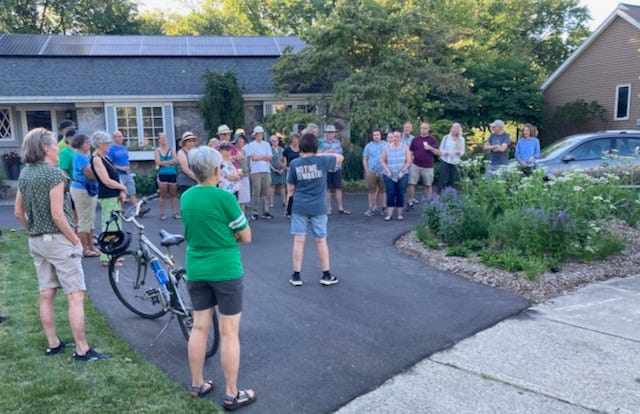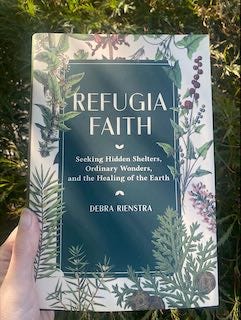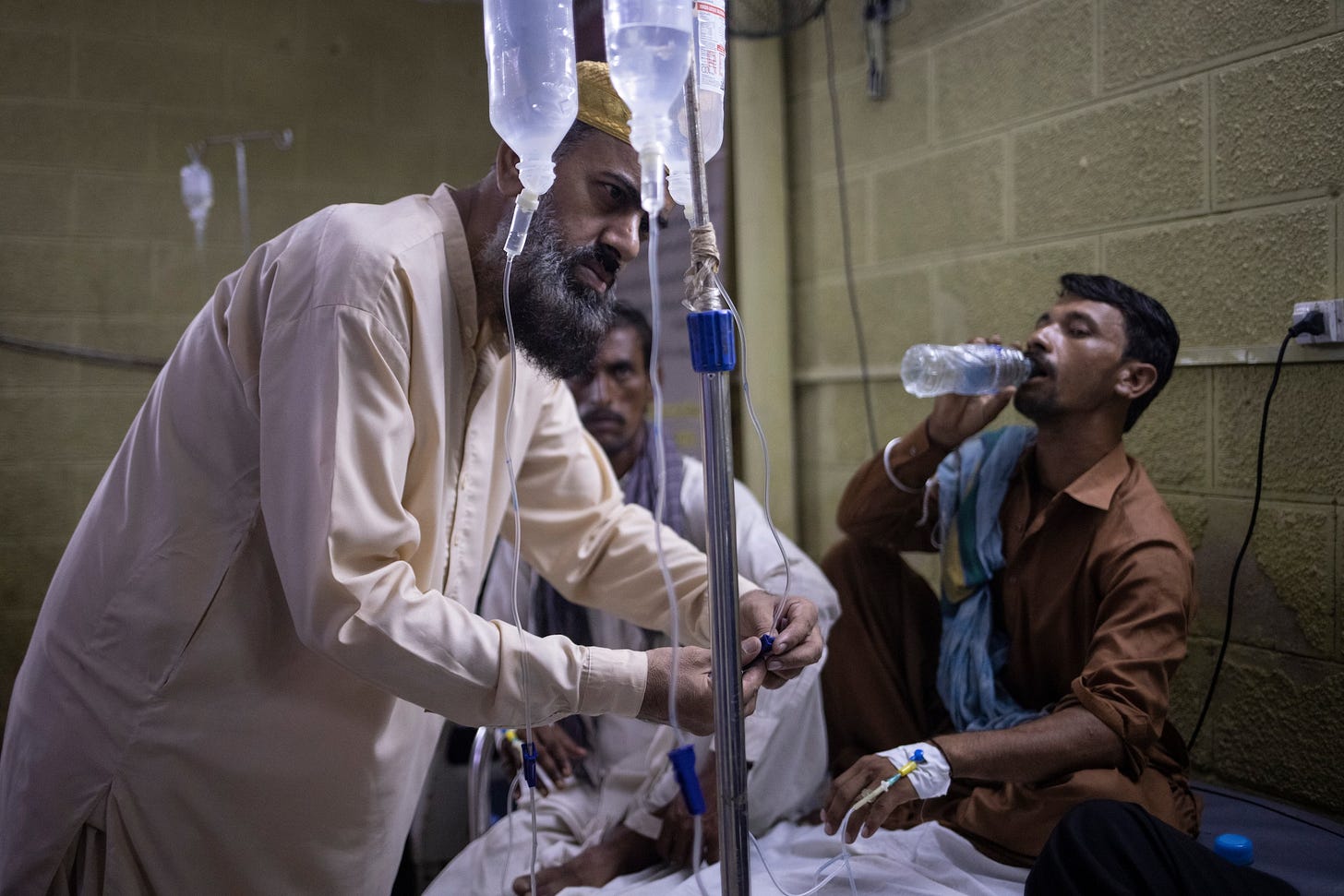Refugia Newsletter #49
Climate strike, IRA for faith groups, disinformation, rewilding, and classic children's literature updated
Refugia News
The ecumenical Season of Creation is becoming one of my favorite times of the Christian year. From September 1 to October 4, Christians around the world focus on our communal vocation to care for and heal the earth. I wrote about how my church observes the Season of Creation two years ago, when we first pulled together a new liturgy and some beautiful liturgical art for the season.
Now the season comes around again, and I welcome our familiar liturgy with its honest laments and praise-filled celebration of God’s love for this world. This year, we’re finding additional ways to engage congregants. We had a fun “refugia garden tour” this week, the brainchild of my friend and colleague, biologist David Koetje. (If you have listened to the Refugia Podcast, you know Dave!) We toured gardens at three member families’ homes, including my messy wildflower gardens and the Koetjes’ incredible botanical wonderland.
Here I am (back turned), telling about the plumbing pipe crisis that became our new native wildflower garden, right in our front lawn. This is only a few of the people who came. We were suprised how into gardening our church family is! (Image credit: David Koetje)
I’m delighted to share with you The Green Lectionary podcast, sponsored by Creation Justice Ministries and hosted by the wonderful Derrick Weston. Pastors: it’s your secret weapon for preaching the lectionary from a “green” point of view! Several of us (pastors and scholars) get together and discuss a lectionary passage in a kind of convivial group exegesis. Episodes are now releasing weekly—check out that August 30 episode on the burning bush passage in Exodus 3.
This week, Third Act Faith released their monthly “Going Deeper” online newsletter, which featured an edited version of one of my talks from the Wild Goose Festival this past summer. It’s called “From Passivity to Citizenship.” Thanks to Mary Jane Cherry for inviting me to contribute. I’ll also be speaking at the monthly online meeting. Join us!
Finally, big thanks to my good colleague Kristin DuMez, powerhouse historian and author of Jesus and John Wayne: How White Evangelicals Corrupted a Faith and Fractured a Nation. (If you haven’t read that book yet, you really should.) Kristin kindly featured Refugia Faith in her own Substack newsletter, “Du Mez Connections” (and her Twitter/X feed) as part of her latest recommended reading list. She even featured the book’s beautiful cover (hat tip, as always, to Fortress Press for that cover). Thank you, Kristin!
I really appreciate the gentle, dappled sunlight and evergreen background in Kristin’s bespoke photo of the book.
This Week in Climate News
So many extreme weather events this summer. They’ve been prominent in the general news, so I don’t have to tell you about Hurricane Idalia or the latest heat waves and wildfires and floods. Part of the danger now is that we just… get used to it. Humans adapt—especially if we’re lucky enough to be more or less OK right now. That’s a strength, but can also be a drawback if we become jaded and indifferent. Two quick news stories today, then, about keeping that sense of urgency vital and focusing on rapid movement toward solutions.
First, the March to #EndFossilFuels, taking place Sept. 17 in New York City. This event is part of a global effort, culminating on Sept. 15 and 17, to demonstrate that people understand the need to transition away from fossil fuels and they have had enough delay, foot-dragging, and obfuscation. You can see planned events all over the world on this map. New York City will be positively bristling with 400 events on its own. The demands of this global project are 1. No new fossil fuels, 2. A rapid, just and equitable phase-out, 3. New commitments for international cooperation, 4. Stop greenwashing, 5. Hold polluters responsible, and 6. End fossil fuel corporate capture (i.e., of lawmakers).
I know this is but one moment in a whole era of protests, building on the legacy of Fridays for Future and the Global Climate Strike. I also know that protests are only one aspect of the climate movement. Still: the cooperation, the single-mindedness, by ordinary people around the world is encouraging.
Second, if you are part of a faith community, has your group investigated how the Inflation Reduction Act might help you and your community transition to renewable energy? I appreciate this concise article from July 20 in Religion News Service, written by Jesuit scholar Thomas Reese. The Biden White House is making an effort to get the word out to faith leaders, and Reese has written a concise summary of what the IRA can do not only to help particular faith communities but to help faith groups serve their larger community, too.
The benefits Reese describes go beyond the tax credits available through the IRA and include competitive grants. These grants are designed to support churches who want to become community hubs for clean-energy transition and climate justice:
DOE wants not only to foster energy efficiency but also energy and climate justice. In most cases, therefore, these new investments must show community benefits. A special program, the Inclusive Energy Innovation Prize, is a competition designed to support entrepreneurship and innovation in communities historically underserved by federal climate and energy technology funding.
Reese’s article is a compelling overview, but for the technical details, I would direct you to Interfaith Power and Light’s website. They’ve been doing the research and technical head-scratching necessary to figure out just how faith groups can draw on federal programs. Scroll down to their webinar links for a great set of tutorials.
Faith groups working with the IRA and other federal programs will want to be especially mindful of the environmental racism that is built into our communities, and the ease with which even well-intentioned people can perpetuate inequities. The savvy policy expert Rhianna Gunn-Wright offers this in-depth analysis of how legacy white supremacy can stick, even amid efforts to create a just transition.
Deeper Dive
One the reasons people—and, sadly, so often North American Christians—drag their feet on climate action is, alas, misinformation and disinformation. So let’s face a dizzying and frustrating contrast a minute: the very real, very present suffering of people in, say, Pakistan, contrasted with the kind of culpable nonsense that gets circulated in the United States.
One thing we know about climate change, even more so after this harrowing summer: There will be much suffering. If you want to see what suffering does and will look like for the most vulnerable people—who face climate ravages first and worst—consider this extensive article on Pakistan by a team of reporters for the Washington Post. Remember those floods, back in 2022? Well, monsoon season comes every year. Things are still desperately bad as heat and rains make life extremely difficult:
Jacobabad [a major city] has always had high temperatures in the summer but climate change is fueling heat waves that arrive earlier and last longer than ever before, which may eventually make the area uninhabitable for even healthy humans, experts say. In Jacobabad, a wet-bulb globe temperature of at least 90 degrees will prevail for a third of the year by 2030, The Post analysis found.
We’re seeing what that distress looks like now, as poor people, many of them displaced by flooding, struggle with heat stroke, food insecurity, malaria and other water- and insect-borne diseases, low birth weights and miscarriages, and poor access to health care. What will rich countries do? We feel the desperation less because we have resources.
“The way the rich countries are going to respond is by spending more to protect ourselves, and in many parts of the world those opportunities don’t exist,” said Michael Greenstone, a University of Chicago economist and [a Climate Impact Lab] study’s co-author.
In many cases, improving odds of survival means one thing — access to air conditioning. A study led by scientists at the University of California at Berkeley projects that less than 1 in 10 Pakistani households will have air conditioning in 2030, compared with 25 percent of Indian homes. In the United States, 92 percent of residents had air-conditioned homes as of 2021.
“Nursing orderly Manzur Ali Sial monitors a lethargic Ghulam Nabi.” Photo and caption credit: Washington Post.
Meanwhile, the denial shenanigans continue. Thank goodness for climate journalist Emily Atkin, who has been busy exposing some real delights in her newsletter Heated. Here, for example, is a revealing piece about Vivek Ramaswamy—he of climate denial fame—who claimed at the debate on August 23 that he is the only Republican candidate who isn’t “bought and paid for.” Yeah, well, turns out he’s making plenty of money on climate denial:
Ramaswamy has reported more than $50 million in holdings in Strive, which to date, is mostly a fund to promote fossil fuel development. As Semafor reports, the largest fund at Strive—called DRLL—“ invests in U.S. energy companies and urges them to keep drilling for oil so long as it’s profitable.”
Atkin refers to Ramaswamy’s rhetoric as “repackaged fossil fuel industry boosterism.”
Emily Atkin (credit: emilyatkin.com)
Then there’s PraegerU. Sigh. Atkin did two pieces on this group, which calls itself “the world’s leading conservative nonprofit.” They appeal to conservatives including conservative Christians, of course, providing slick education materials for kids that spread climate misinformation. Atkin writes:
PragerU’s materials, which have been widely reported on by mainstream media, falsely claim that heat records around the world are “natural;” that wind and solar power pollute the Earth and make life miserable; and compare climate activists to Nazis.
We weren’t surprised PragerU would make these claims. The group—which despite its name, is not a university—“has received millions of dollars from the billionaire brothers Farris and Dan Wilks of Texas, who made their fortune in oil and gas fracking,” Politico reports.
If you want to get yourself riled up, just go watch a few of their “educational” videos. Atkin has covered their shenanigans (and false claims) aimed at getting their materials approved for use in Florida and Texas public schools. Educators, read this article for a cautionary tale.
There’s more! Atkin was involved in the dust-up about ABC’s misleading headline that claimed the Maui wildfires were not caused by climate change, their correction, and the backlash about that correction.
She also investigated the “anti-woke investing movement,” focused in part on ESG measures. ESG [which stands for environment, social, and governance] is not by any means the perfect set of measures for corporate responsibility on climate, but the weird recent backlash has, as Atkin puts it understatedly, “curious origins”:
The anti-ESG movement is, at its core, a lobbying effort created by climate deniers to make money for fossil fuel companies. It did not originate with financial experts or economists, but with two prominent industry operatives who’ve spent decades spreading disinformation about the human health risks of fossil fuels and cigarettes.
If you are not yet bummed out enough about all this—well, there’s more. Here’s a whole series on the Drilled podcast about the global rise in harassing and arresting climate activists.
And finally, here’s a super fun round-up of all the conspiracy theories circulated to explain this summer’s numerous extreme weather events and disasters, by Tiffany Hsu in the New York Times. Truly, some of these theories are so silly they’re amusing. I especially love the “directed energy weapon” that, according to “photo proof” making the social media rounds, caused the Maui fires.
To be fair, this is a really cool photo. But it was taken in California. It’s the launch of the SpaceX rocket in 2018. Image: SpaceX/ZUMA/picture alliance.
Refugia Sighting
OK, that’s enough with the discouraging news. There’s so much good news, too, including the way people are creating meaningful refugia all over the world.
How about some fall leaf-peeping as a simple refugia moment? Here’s a sweet little resource suitable for taking young children out to enjoy the beauty of seasonal changes in the US. The website will help you review all the science, so you can sound extremely wise as you explain it all to the kids.
And here’s a wonderful refugia sighting: “Tiny forests” are popping up all over the US, and indeed the world. More precisely, they are being created based on the method pioneered by Japanese ecologist Akira Miyawaki. These forests can be small, urban, and powerfully effective. From an article by Cara Buckley in the New York Times:
“This isn’t just a simple tree-planting method,” said Katherine Pakradouni, a native plant horticulturist who oversaw the forest planting in Los Angeles’s Griffith Park. “This is about a whole system of ecology that supports all manner of life, both above and below ground.”
Miyawaki’s dense planting method means that little forests—maybe the size of a tennis court or football field—can start thriving in just a couple years and “mature” in only ten—unlike the centuries it takes without intervention. The forests provide wildlife habitat, beauty, cooling, water absorption, carbon capture, and delight.
Look at this cute little forest! “A Miyawaki Forest in Danehy Park, near Harvard University in Cambridge, Mass.” Image Credit: Cassandra Klos for The New York Times
The Wayback Machine
We’ll conclude with a little affectionate snark. I can’t believe I haven’t shared this cheeky little piece with you yet. I wrote it in 2019 after re-reading, just for fun, the Laura Ingalls book The Long Winter. I started wondering what it would look like to update children’s classics to reflect new climate realities. Things went downhill from there… so I present “Children’s Classics Updated for the Age of Climate Chaos.”
“But all this rain after those wildfires last summer!” Laura contradicted. “The Big Slough is now the Very, Very Big Slough.”
“We mustn’t complain, Laura,” scolded Ma.
Meanwhile, Almanzo and his friend put on their waders, determined to trudge miles to a nearby homestead where—rumor has it—a neighbor has a supply of antibiotics needed to ward off the bacterial infections everyone is getting from the swampy conditions.
“Shucks,” said the little bunny, “I guess we are now climate refugees.” (Image by Clement Hurd.)
Whatever challenges you are facing, I hope you are finding beauty, humor, and trusted companionship. Till next time, be well.











